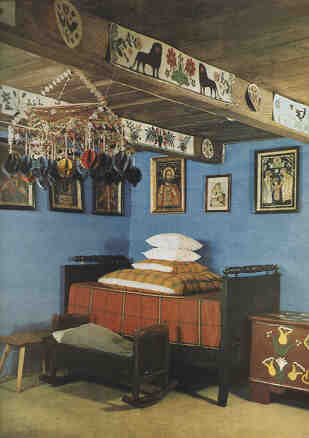
Wicinanki - Then and Now
by Peter K. Gessner
|
|
|
|
As peasant families emigrated in the latter part of the 19th century to America, they brought wycinanki tradition with them. Here it has continued to remind them of their ancestral village life. In Poland, as people in the villages begun emulating city ways, the art of making wycinanki all but disappeared. Following WWII, it was revived in what was known as "People's Poland," the communist regime imposed on Poland by the Soviets as a consequence of the Yalta Accords. Seeking to differentiate itself from Poland's pre-war "bourgeois" democracy and masquerading as the "dictatorship of the proletariat," the regime, seeking to somehow legitimize itself in the eyes of the masses, invested heavily in the folk-arts. The wycinanki were thus often used to decorate official building. Given their artistic and decorative merits, not to mention their beauty, it became fashionable, for a time, among city dwellers to frame the wycinanki and used them as interior decorations.
As time went on and tourism increased, the regime's Cepelia stores created a demand for folk art products, the wycinanki among them, and sold them to foreign tourists at very competitive prices as a way to earn hard currency and ease the regime's balance of payments problems. With the fall of communism in 1989 and the advent of the free market, the demand for the wycinanki diminished greatly, practitioners of the craft scaled back their production.
This history has led to what John Radzilowski, writing in 1999, termed a fundamental disjuncture between Poles and Polish Americans. "The vision of Poland held by Polish Americans" he wrote, "expressed in crafts like folk dancing, egg decorating, wycinanki, was formed here in America and represents a strong ethnic heritage." But the Poland of today, he added, is not the same Poland from which the grandparents of the Polish Americans came. It is a modern nation, with a rich modern culture of which the Poles are justly proud.[1]
Outside of ethnographic museums and elementary schools, the wycinanki today have as much currency in Poland as cowboys do in America: appreciated for its historical value but no longer of major relevance to the modern nation. Accordingly, Poles tend to bemoan when consciousness of Poland in some American circles is limited, as it at times happens, to the wycinanki and the country's other folk arts to the exclusion of the nation's more salient cultural achievements.
1. http://www.informatics.sunysb.edu/apap/archives/1999/0782.html
| Info-Poland a clearinghouse of information about Poland, Polish Universities, Polish Studies, etc. |
